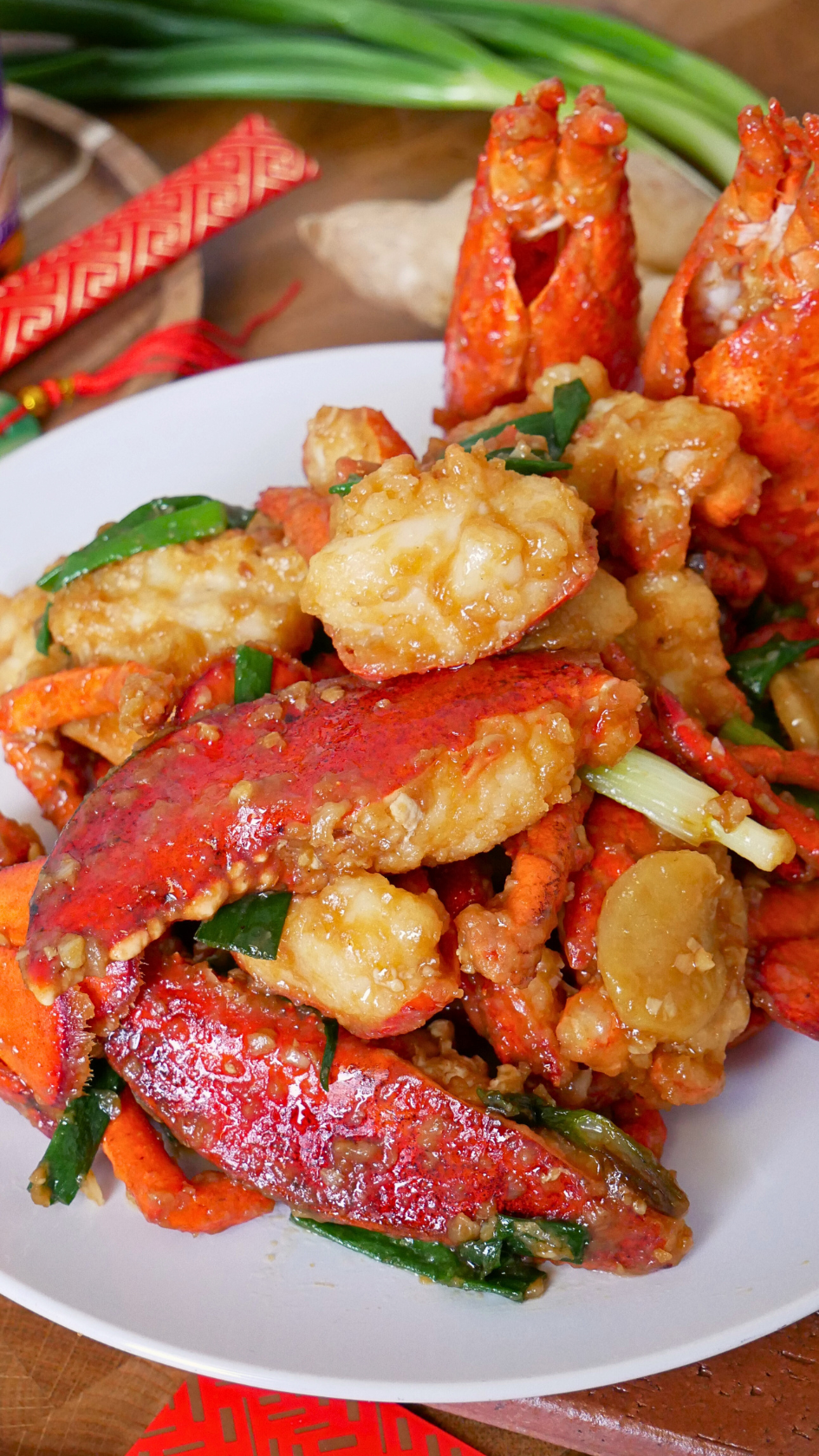Cantonese-Style Ginger Scallion Lobster is a classic Chinese Lunar New Year dish that’s made with chunky portions of shell-on lobsters stir-fried with scallions, ginger, garlic, Shaoxing wine, and tossed with a lightly seasoned sauce for a truly scrumptious meal.
When it’s Lunar New Year, you usually find ginger scallion lobster served alongside some of these classic dishes including:
- Honey walnut shrimp
- Easy garlic chili oil noodles
- Chinese steamed fish
- Chinese shrimp fried rice
- Tang yuan
Plus many other Chinese celebration staple dishes. But even if there’s no occasion, this recipe is a delicious way to serve lobsters to your friends and family. To complete the meal, I usually like to serve this lobster dish with pea shoots with garlic and some freshly cut pineapple to end the meal.
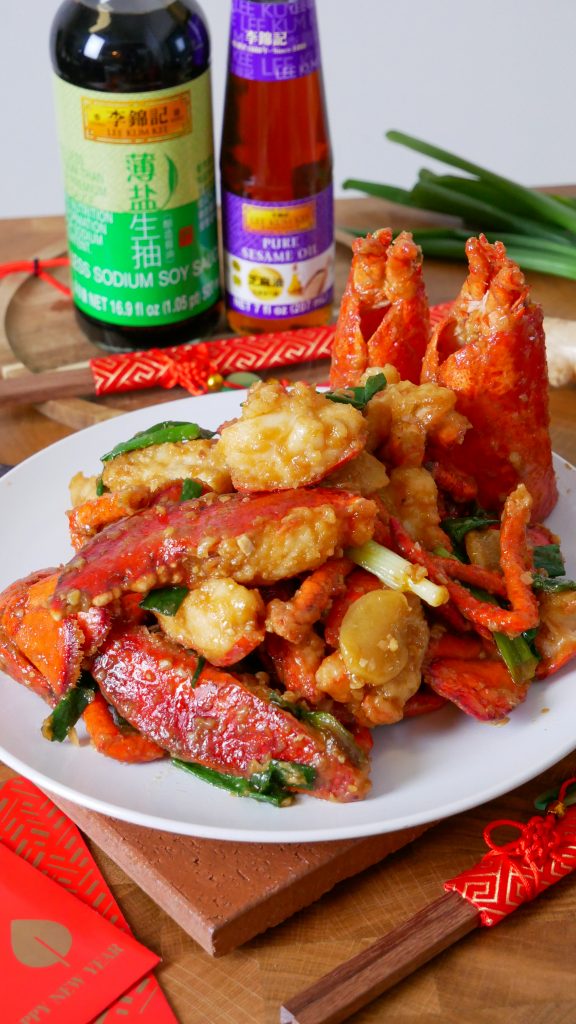
Why you’ll love this recipe
You’ll be surprised how relatively easy and straightforward it is to make such a sophisticated-looking platter. This lobster dish comes together in less than 1 hour, with 30 minutes of freezing time included! So that’s only a few minutes of hands-on time for chopping and actual cooking. I used live whole lobsters but to save time, you can use fresh or frozen lobster tails!
The overall flavor of the dish is savory with hints of sweetness from the scallions and lobster. The sauce has a mild soy sauce and umami flavor that is delicately balanced out by sugar. The addition of the Shaoxing wine makes a huge difference! This cooking wine deglazes the brown bits off the pan—those are flavor bombs!—so they get incorporated with the sauce.
Now the trick to keeping the lobster plump and juicy is coating the lobster chunks with cornstarch. This creates a thin, light, and crisp outer layer which is where the sauce sticks. It also helps seal in the juices so that the cooked lobster meat remains moist!
Ginger Scallion Lobster Ingredients and Substitutions
Lobsters: For this recipe, live and fresh is best but do keep in mind that you will have to dispatch it unless you ask your fishmonger to do this for you. To speed this up, you can use fresh or frozen lobster tails!
Cornstarch: Creates a light outer coating that turns crispy after frying. It is also what helps the sauce to stick to the lobster pieces. This can be substituted with potato starch.
Ginger: Ginger is the aromatic that is almost always essential to Chinese-style seafood dishes because it cuts through the briny taste and neutralizes any underlying odors.
Scallions: Adds a freshness, and bright taste and aroma! It contributes to the fragrance of the overall of this dish while also adding a pop of green color.
Garlic: Adds a depth of flavor that enhances the flavor of the sauce. Feel free to add more, but not less!

Shaoxing wine: This is a Chinese cooking wine that’s used to deglaze the pan, which has tons of flavor that gets mixed in with the sauce. Shaoxing wine also adds umami and a delicious savory aroma, and will make this dish taste just like the restaurants! Shaoxing wine can be substituted with Sherry wine or skipped.
Neutral oil: about 2 to 3 cups will be needed for frying. Avocado, peanut, sunflower, and canola are all good options – basically any neutral-tasting oil with a high smoke point!
Salt: Seasons the dish
Sauce Ingredients and Substitutions
Water: Added to loosen and dilute the sauce.
Low-sodium Soy Sauce: I prefer using low-sodium soy sauce to better control the saltiness. Feel free to substitute this with regular light soy sauce – just reduce the amount added and taste to adjust.
Sesame oil: Added for a touch of nuttiness, richness, and boldness.
Sugar: Cuts through the savoriness for a more balanced flavor profile. This can be substituted with honey.
Chicken bouillon: For an added layer of umami and savoriness
Ground white pepper: Adds a mild spice and floral undertone. This can be substituted with ground black pepper.
Starch Slurry Ingredients and Substitutions
Cornstarch: Used to thicken the sauce
Water: For diluting the cornstarch before it hits the hot pan
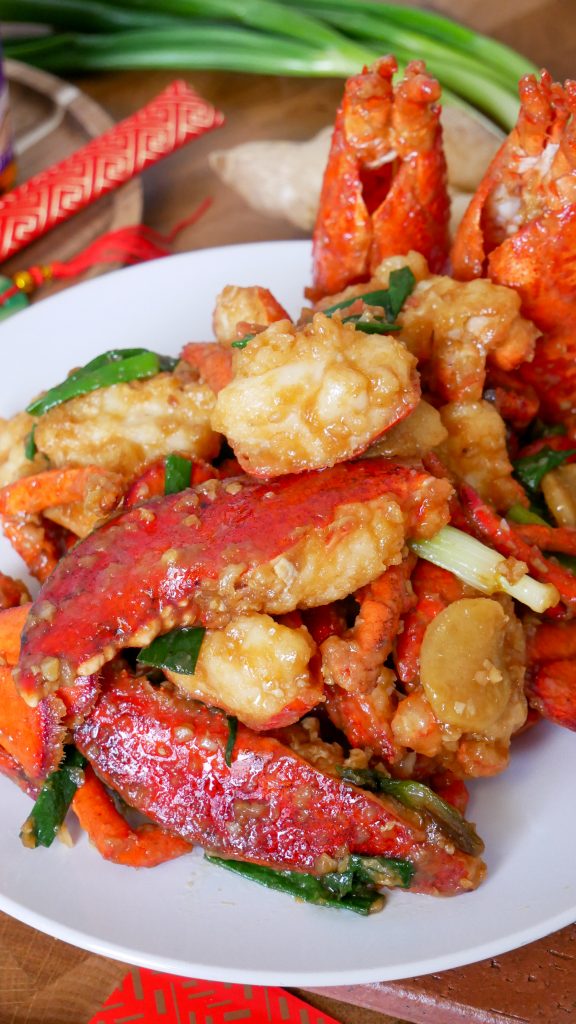
How to Prepare Ginger Scallion Lobster
Step 1: Freeze the lobsters
Place the lobsters in the freezer for 30 minutes to 1 hour. This will put them to sleep, making it easier to process later. You can skip this if using lobster tails. If your lobster tails are frozen, thaw them in the fridge the night before.
Step 2: Kill the lobsters
Take the lobsters out of the fridge and lay them out on a cutting board. Using a chef’s knife, pierce the head of the lobster all the way through. The nerve endings of the lobster will cause its body to continue moving; however, the lobster is already killed at this point.
Step 3: Dispatch the lobsters
Pull off the lobster head and remove the brain, organs, and tomalley (yellow/greenish substance). Using a cleaver, chop the mouth and claws off and set the claws aside. Scrape away the gills then carefully cut straight down to cut off the gills and legs on both sides. If you want to keep the legs, set those aside otherwise you can toss them.
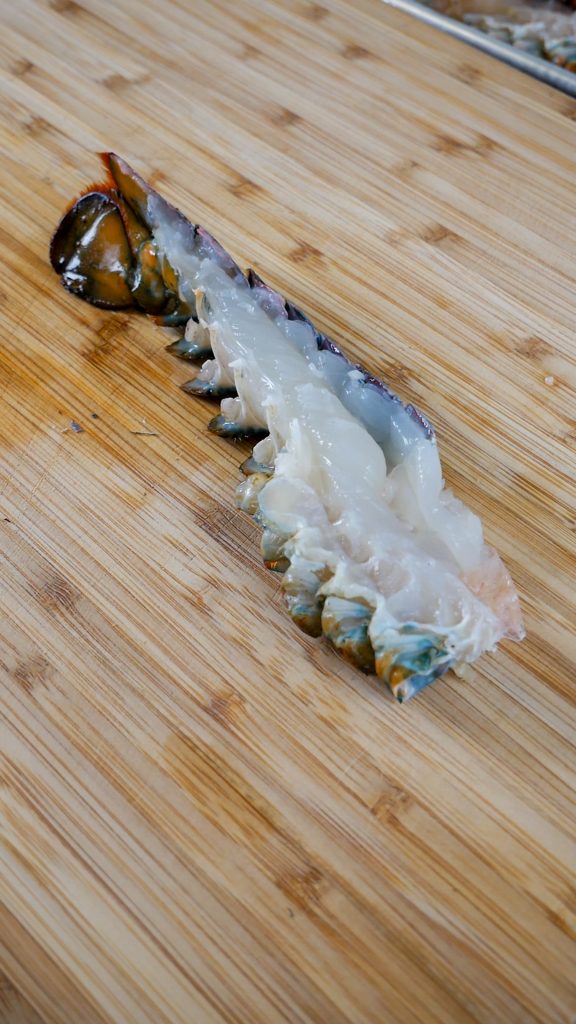
Step 4: Cut the claws
Carefully cut the elbows of the lobster claws in half lengthwise, followed by the claw.
Step 5: Cut the tails lengthwise
Lay the lobster tail and body flat onto the cutting board and split the lobster down the middle lengthwise into two pieces. Next, remove the sand tract and digestive tract.
Step 6: Chop the lobsters
Cut each lobster half into 4 pieces (1 body and 3 tail pieces), leaving you with 8 pieces total per lobster. If using lobster tails, cut it straight down the middle lengthwise. Chop each half into 3 pieces, leaving with 6 pieces total per tail.
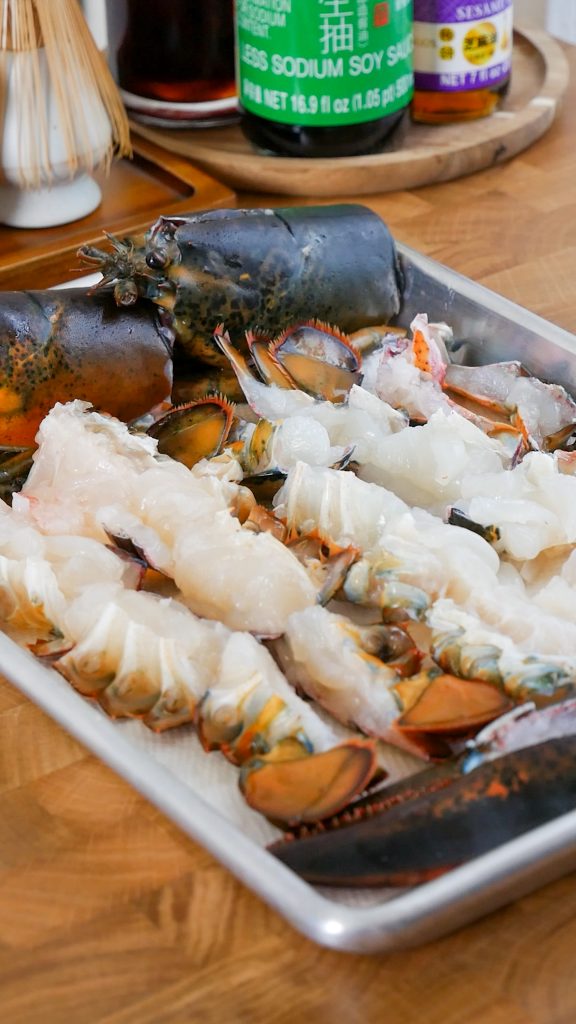
Step 7: Rinse and dry
Rinse the lobster pieces under cold running water to get rid of any stray shells. Using a paper towel, pat dry the lobster pieces well and set aside to air dry.

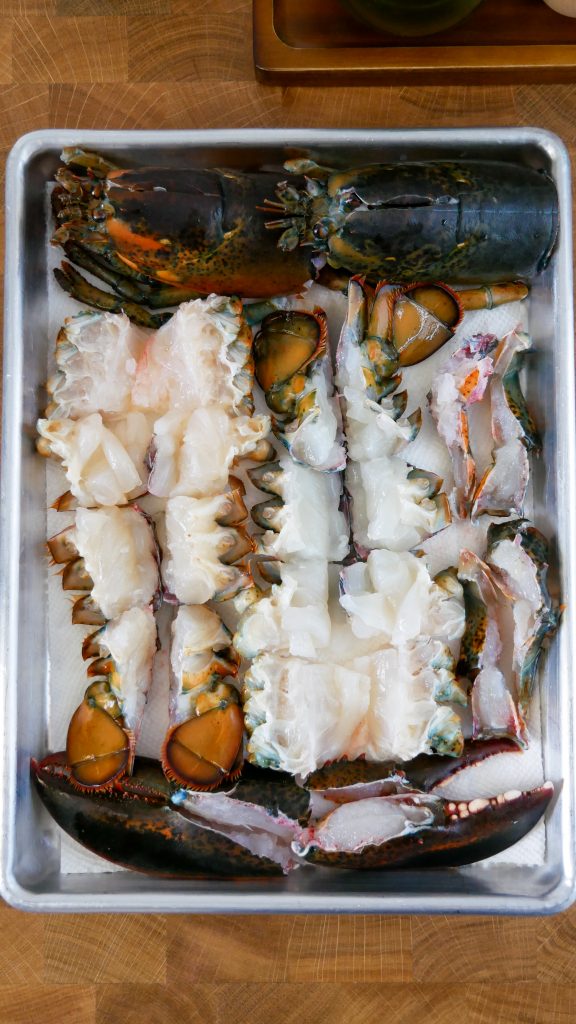
Step 8: Prepare the sauce components
In the meantime, combine the sauce ingredients which include water, low-sodium soy sauce, sesame oil, sugar, chicken bouillon, and ground white pepper. Mix well then set aside. Next, prepare the starch slurry by mixing together cornstarch and water. Set aside for later.
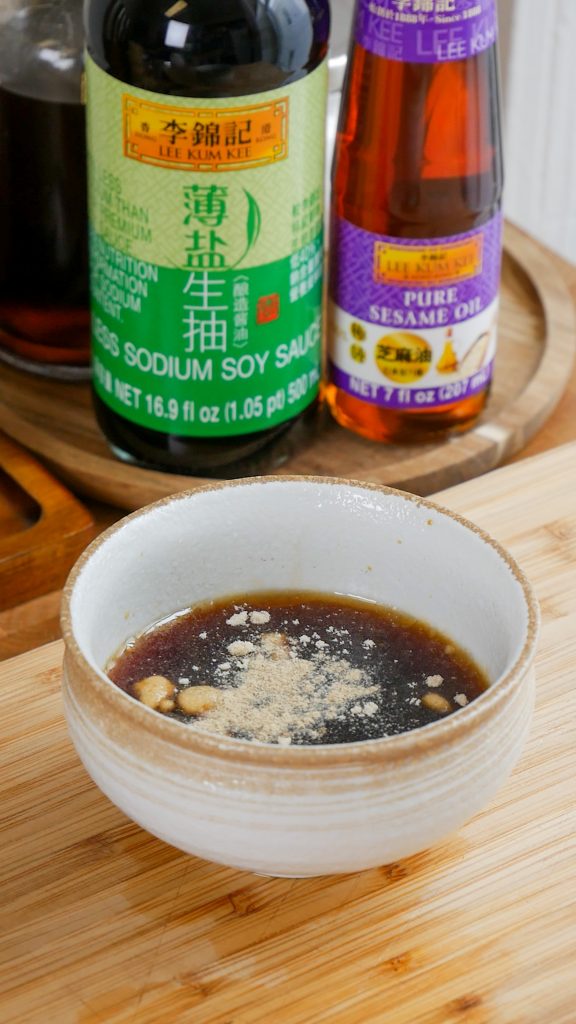
Step 9: Dredge the lobsters
Add cornstarch to a large mixing bowl and toss and coat the lobster, making sure all pieces are well coated. Dust the cornstarch off well by transferring the coated lobster pieces into a colander or large strainer. You can also dust each piece by hand.
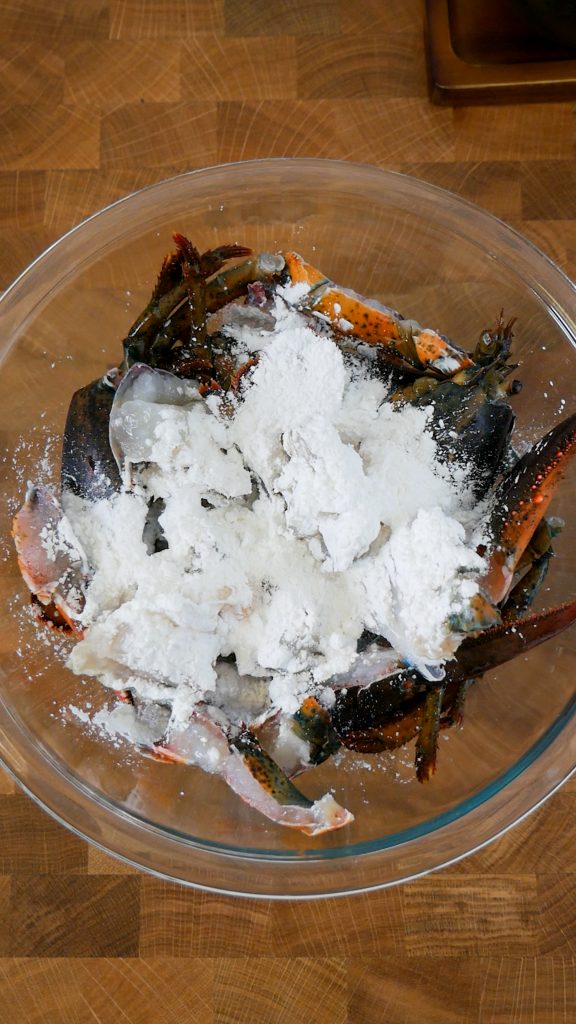
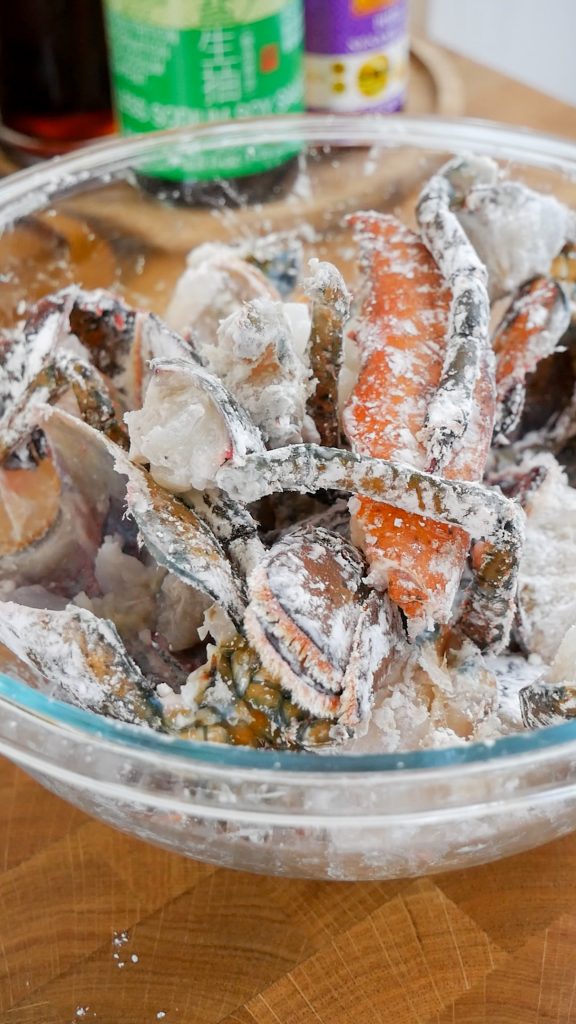
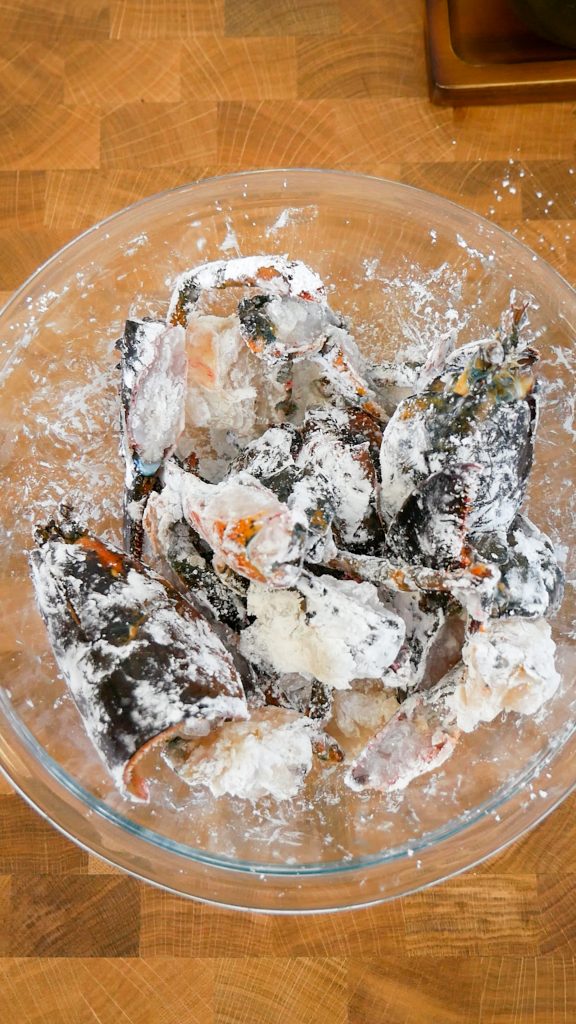
Step 10: Flash fry the lobsters
In a pot or wok over medium heat, heat 2 to 3 cups of neutral oil to 375F (190C). Flash fry lobster pieces for 20 seconds, making sure to work in batches to prevent overcrowding the pot. Transfer the lobster to a wire rack to drain and immediately hit it with salt. Repeat until all the lobster has been flash-fried.
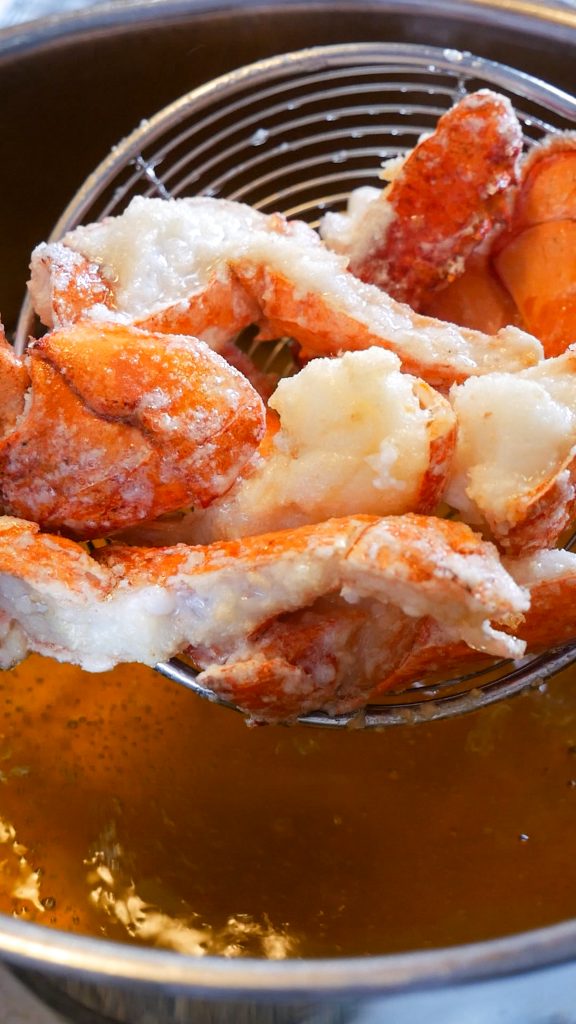
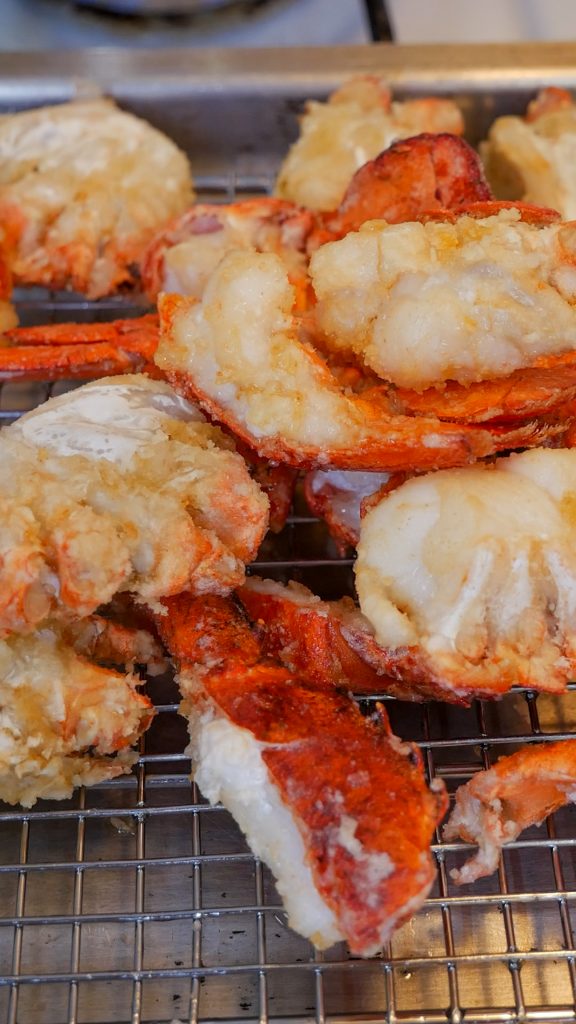
Step 11: Stir fry
In a clean wok, heat 2 tablespoons of neutral oil over medium-high heat. Toss in the ginger and saute for 30 seconds, or until fragrant. Add the white part of the scallions and saute for another 30 seconds, before adding in the minced garlic. Saute for 30 seconds then add lobster chunks and stir to mix well.
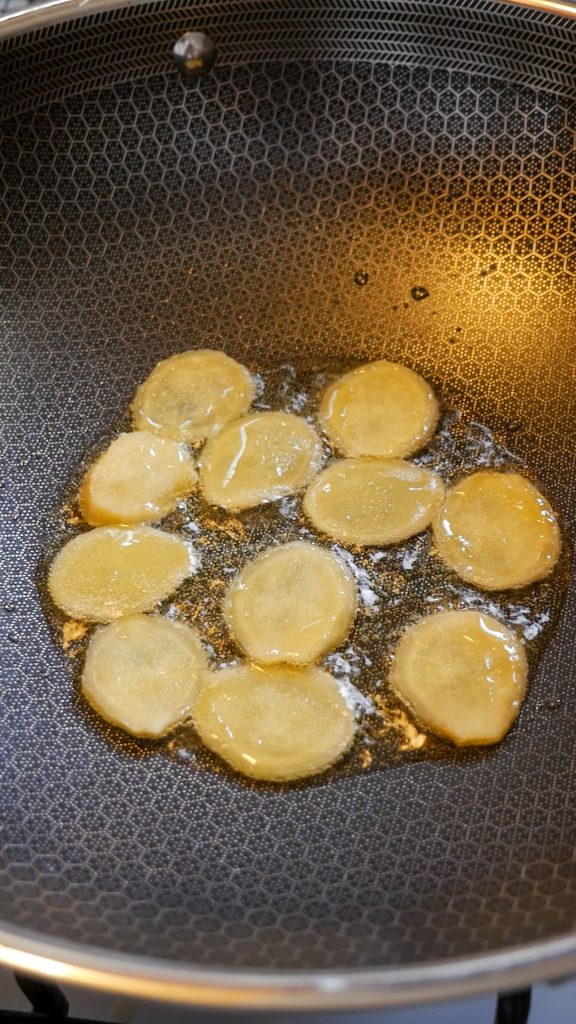

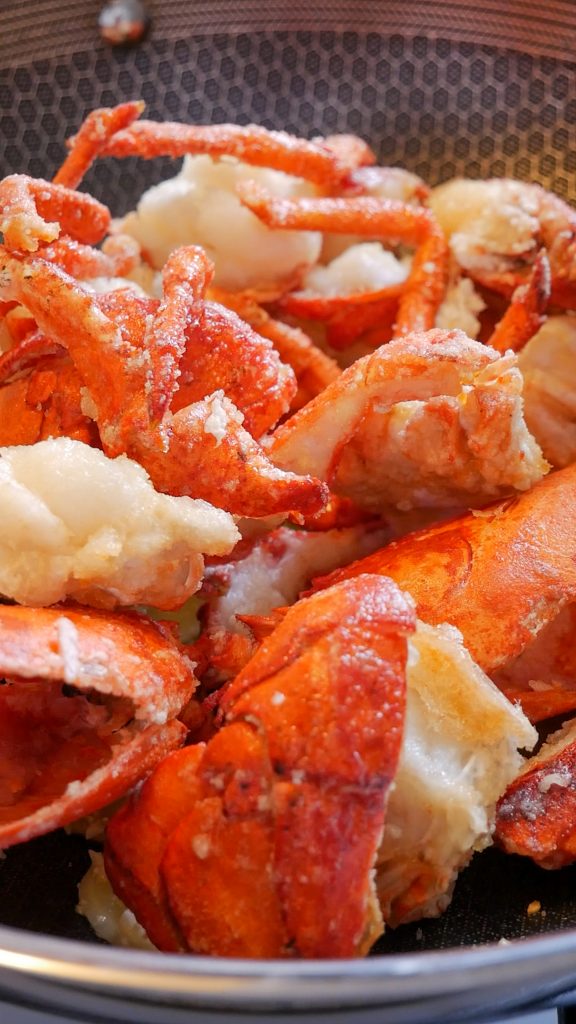
Step 12: Deglaze with cooking wine
Pour the Shaoxing wine around the wok and stir fry for about 2 minutes. Add the sauce and toss to mix well.
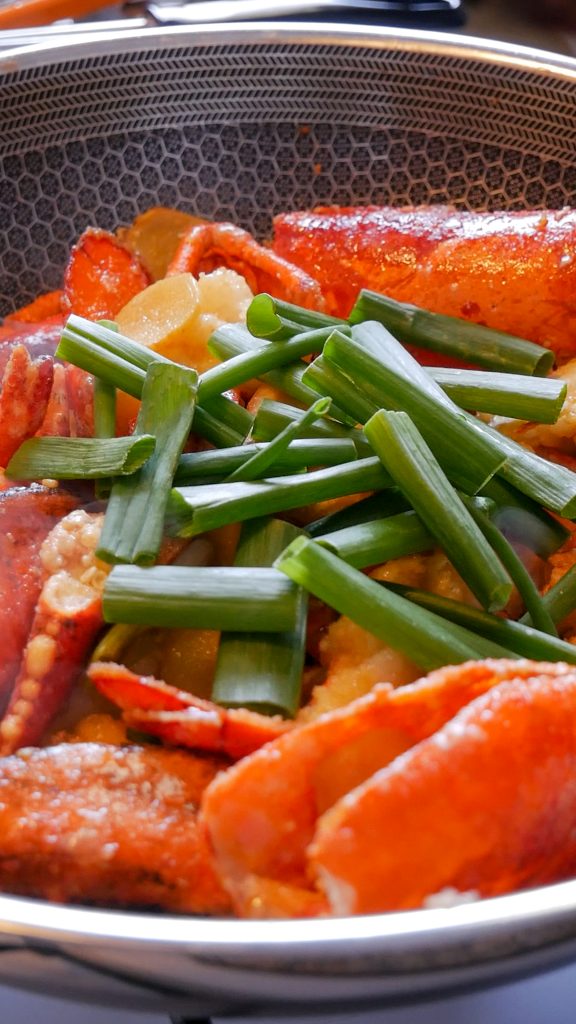

Step 13: Thicken the sauce
Once the lobster has been coated in the sauce, add the starch slurry and mix everything together. Add the green part of the scallions and give it one last toss. Serve and enjoy!
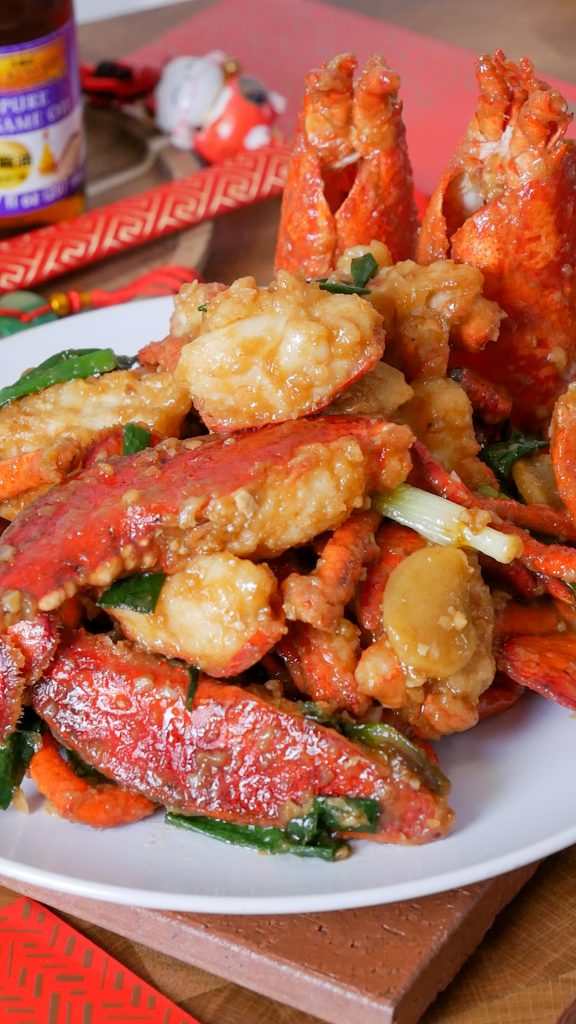
Preparation Tips for Cantonese Style Ginger Scallion Lobster Recipe
Here are some helpful tips to ensure you make a delicious restaurant-quality homemade version of this dish every time:
- Use the freshest lobsters you can find. Fresh lobsters have the best flavor and nice firm texture that holds up through the frying. The ideal size is 1 to 1 1/2 pounds each. If you’d like, you can use frozen or fresh lobster tails.
- Pat dry the lobsters using paper towels before dredging them in cornstarch so that the cornstarch will stick better.
- Preheat the oil before frying. If the oil is not hot enough, the lobster will absorb much oil and will turn out greasy. Also, do not overcrowd the frying pan. I recommend working in batches and using a thermometer for accurate temperature readings.
- Prepare this dish right before serving it. It’s best eaten when it’s right out of the wok so that the sauce is hot and thick and the cornstarch coating on the lobster pieces is still crisp.
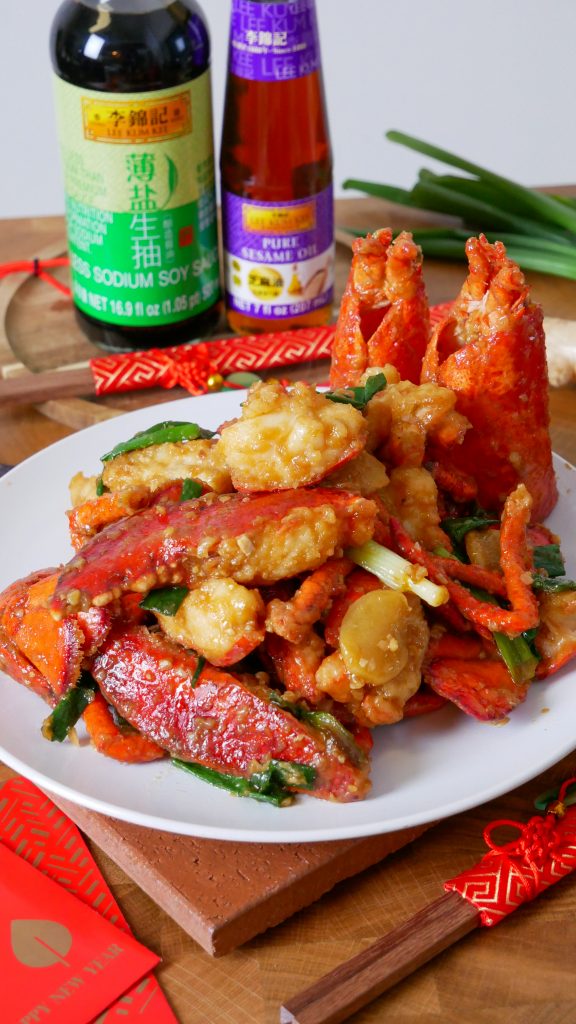
Frequently Asked Questions
How to cut lobster Chinese style?
The very first thing you have to do before cutting a lobster is to put it to sleep. Place the lobster in the freezer for 20 minutes or so until it gets sluggish. You’ll it’s ready to be processed by lifting it up and giving it a wiggle. The claws should look like jelly and sluggish, which means they are now numbed and won’t feel pain.
Next, lay them flat on your cutting board. Locate the brain right in between the eyes, and poke right through it using a pointed knife, but not all the way if you want to keep the head whole. Then, pull the head off. Remove any internal organs and set the shell aside for serving. Scrape the gills then cut them off and discard. Also, cut the legs and claws off.
With the lobster still lying flat on the cutting board, chop the head/body section. Cut it lengthwise. Do the same with the tail, removing the tomalley or the yellow-greenish stuff inside the lobster. Then, cut each lobster’s tail half into three equal parts. You now have 8 parts.
Next, for the claws, turn the lighter part facing up. This is the side that’s less slippery than the dark part and is therefore easier to cut through. Separate the elbows from the claws then cut both the elbows and claws across.
Your lobster is now chopped and ready to cook!
What type of lobster is best for ginger scallion lobster?
The best lobster for this recipe is live and fresh, weighing around 1 to 1 1/2 pounds a piece. You can substitute this with fresh or frozen lobster tails.
How can I tell if my lobster is fresh?
Fresh lobsters will be active and will react to movement. They should smell clean, not too fishy, and with no off-putting smell.
How to store leftover lobster with ginger and scallions?
Store the leftovers in an airtight container in the fridge. They will stay good for up to two days, but I recommend consuming them as quickly as possible. To reheat, set them in the microwave on high for a minute or 2 or until heated through.
Looking for more easy and delicious Chinese-inspired recipes?
Steamed Chilean Sea Bass — Tender and flaky Chilean sea bass is steamed with scallions and ginger, and seasoned with soy sauce, cilantro, seafood soy sauce, and oil. Perfect with a bowl of white rice for a comforting meal!
Air Fryer Char Siu — Char siu or Chinese BBQ Pork, but make it easy! This air fryer char siu recipe is for all my lazy folks out there who want restaurant-quality char siu without having to put in extra time and effort.
Char Siu Fried Rice — Now here’s a delicious way to use up leftover char siu and rice. Made with onion, garlic, green pepper, carrots, scallion, eggs, and a special sauce to tie them together.
Chinese Scrambled Egg with Shrimp — Ten minutes and a handful of common ingredients are all you need to prepare this dish! The ingredients are simple and easily accessible – all that’s required are eggs, shrimp, and a few everyday pantry staples.
Chinese Tea Eggs — Soft-boiled eggs marinated in a mixture of tea, soy sauce, and spices for the ultimate snack or addition to any dish. They’re super flavorful and easy to make!
Chinese Garlic Fried Rice — Give your leftover rice a makeover by making garlic rice. If you’re a garlic lover, this is for you!
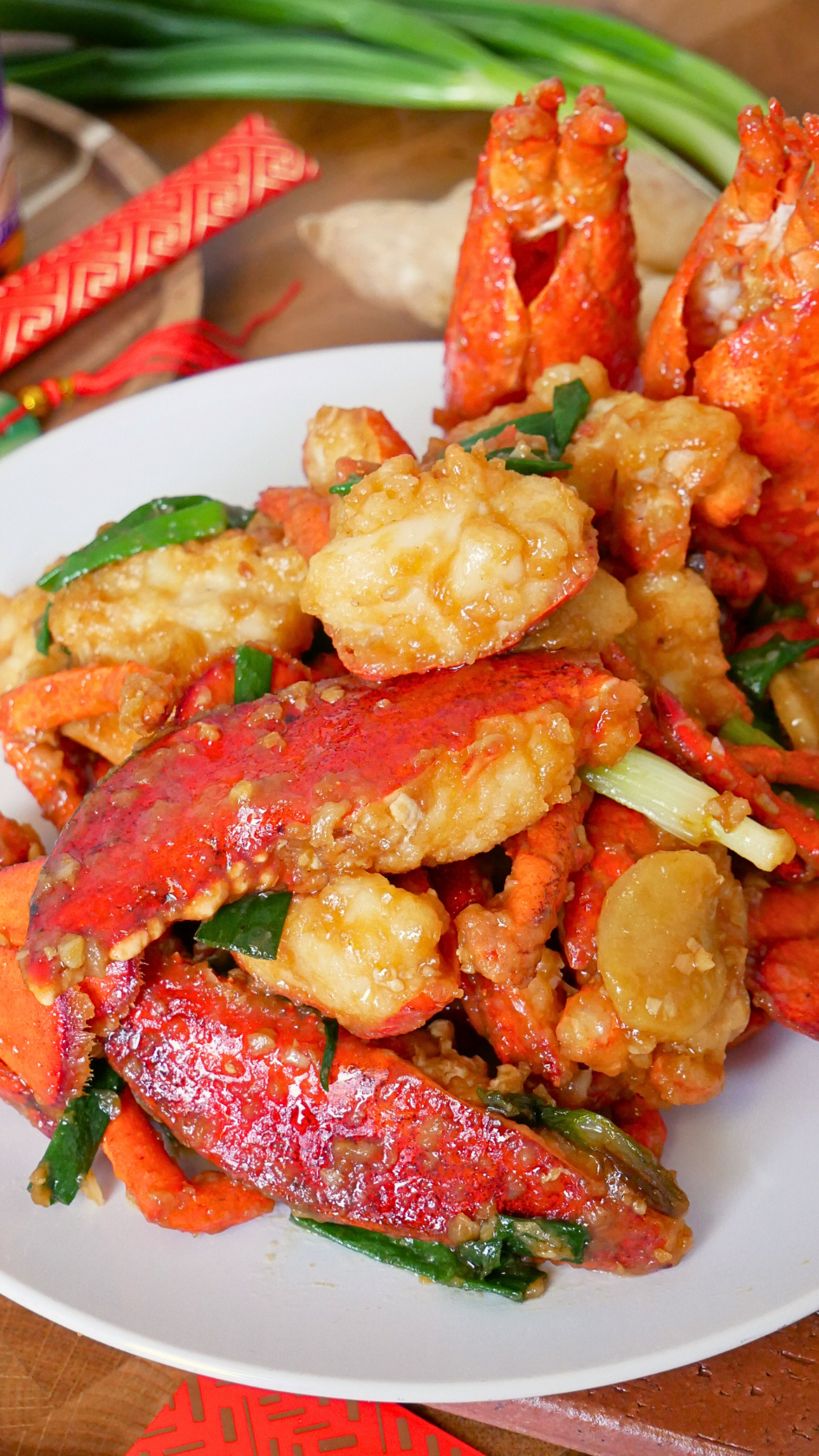
Cantonese Style Ginger Scallion Lobster Recipe
Ingredients
- 2 live lobsters about 1 to 1 ½ pounds each, substitute with fresh lobster tails
- 1/4 cup cornstarch
- 8 slices ginger
- 4 scallions cut into 2-inch pieces
- 4 garlic cloves minced
- 3 tbsp Shaoxing wine
- 2 tbsp neutral oil plus more for flash frying (about 2 to 3 cups)
- 1/2 tsp salt
Sauce
- 1/4 cup + 2 tbsp water
- 2 1/2 tbsp low-sodium soy sauce
- 1/2 tsp sesame oil
- 1 tsp sugar
- 1 tsp chicken bouillon
- 1/8 tsp ground white pepper
Starch Slurry
- 1 tbsp cornstarch
- 1/4 cup water
Instructions
- Place the lobsters in the freezer for 30 minutes to 1 hour. This will put them to sleep, making it easier to process later.
- Take the lobsters out of the fridge and lay them out on a cutting board. Using a chef knife, pierce the head of the lobster all the way through. The nerve endings of the lobster will cause its body to continue moving however, the lobster is already killed at this point.
- Pull off the head of the lobster and remove the brain, organs and tomalley (yellow/green-ish substance). Using a cleaver, chop the mouth and claws off and set the claws aside. Scrape away the gills then carefully cut straight down to cut off the gills and legs on both sides. If you want to keep the legs, set those aside otherwise you can toss them.
- Carefully cut the elbows of the claws in half lengthwise, followed by the claw.
- Lay the lobster tail and body flat onto the cutting board and cut straight down the middle lengthwise into two pieces. Next, remove the sand tract and digestive tract.
- Cut each lobster half into 4 pieces (1 body and 3 tail pieces), leaving you with 8 pieces total per lobster. If using lobster tails, cut it straight down the middle lengthwise. Chop each half into 3 pieces, leaving with 6 pieces total per tail.
- Rinse the lobster pieces under cold running water to get rid of any stray shells. Using a paper towel, pat dry the lobster pieces well and set aside to air dry.
- In the meantime, combine the sauce ingredients which include water, low-sodium soy sauce, sesame oil, sugar, chicken bouillon, and ground white pepper. Mix well then set aside. Next, prepare the starch slurry by mixing together cornstarch and water. Set aside for later.
- Add cornstarch to a large mixing bowl and toss in the lobster, making sure all pieces are well coated. Dust the cornstarch off well by transfering the coated lobster pieces into a colander or large strainer. You can also dust each pieces by hand.
- In a pot or wok over medium heat, heat 2 to 3 cups of neutral oil to 375F (190C). Flash fry the lobster for 20 seconds, making sure to work in batches to prevent overcrowding the pot. Transfer the lobster to a wire rack to drain and immediately hit it with salt. Repeat until all the lobster have been flash fried.
- In a clean wok, heat 2 tablespoons of neutral oil over medium-high heat. Toss in the ginger and saute for 30 seconds, or until fragrant. Add the white part of the scallions and saute for another 30 seconds, before adding in the minced garlic. Saute for 30 seconds then add the lobster and stir to mix well.
- Pour the Shaoxing wine around the wok and stir fry for about 2 minutes. Add the sauce and toss to mix well.
- Once the lobster have been coated in the sauce, add the starch slurry and mix everything together. Add the green part of the scallions and give it one last toss.
